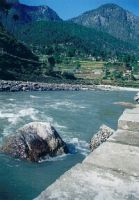Siddhayoga
Hindu sect From Wikipedia, the free encyclopedia
The Tirtha lineage of Siddhayoga is a mystical sect of Shaivite Hinduism. It emphasizes direct encounters with life force, or kundalini shakti, and understanding the Shastras.[citation needed] Central to this tradition is the guru-disciple bond, where the guru transfers shakti (divine energy) to the disciple through a transformative process called Shaktipat. Shakti is said to be automatically infused into a disciple by a guru in this process.[1][citation needed]
This article has multiple issues. Please help improve it or discuss these issues on the talk page. (Learn how and when to remove these messages)
|

Within the realm of Siddhayoga, numerous lineages exist. Some lineages share a common origin, while others have no connection whatsoever. Additionally, various groups—despite not using the specific term Siddhayoga—discuss the infusion of kundalini shakti.[2] This approach is known by many names, including siddha yoga, sahaja yoga, mahayoga, and siddha mahayoga.[3]
Similar teachings may be traced back to Tantric masters, including the scholar Abhinavagupta.[4] Shakti is considered the energy of an eternal soul, accessible regardless of religion. For this reason, Siddhayoga is sometimes regarded as universal rather than exclusively Hindu.[citation needed]
Scriptural Sources
Summarize
Perspective
Siddhayoga aims to uncover an eternal source of abundance for all—peace, creativity, spiritual energy, and the eternal soul. The guru plays a crucial role in facilitating this transformation for the disciple. The Yoga Vani stands as the most significant scripture within this tradition and provides vital guidance along the path of Siddhayoga.[5][citation needed]
The siddhayoga guru prepares the kundalini shakti, which automatically becomes infused in the disciple at the muladhara chakra. This awakens and raises spiritual energy up the Sushumna.[6] Various ancient texts discuss the transformative effects of proximity to the guru. The Kularnava Tantra states: "An intelligent person should regard this teacher as their preceptor by whose contact inexpressible bliss is produced in the disciple."[7] The Yoga Vasistha says: "A real preceptor is one who can produce blissful sensation in the body of the disciple by their sight, touch, or instructions."[8]
Siddhayoga is described as an internal transformation, allowing individuals to grow into their true nature regardless of external practices, rites, and rituals. It emphasizes a unique path for each individual (dharma), tailored to their own desires and balance with nature's rhythms. Those seeking connection with their soul or God, striving for mental peace, or aiming to harmonize with people, animals, and nature may find these higher aspirations fulfilled through Siddhayoga's transformative experiences and development of inner divine love.[9]
Siddhayoga lineage
Summarize
Perspective

Swami Shankar Purushottam Tirtha (1888-1958) descended from two monastic lines. He was first initiated into Siddhayoga by Swami Narayana Dev Tirtha (born c. 1879), whose own spiritual lineage was through Swami Gangadhara Tirtha. Swami Shankar Purushottam Tirtha then took sannyas under Swami Bharati Krishna Tirtha in Puri. During Swami Bharati Krishna Tirtha's visit to America, Swami Shankar Purushottam Tirtha was asked to maintain the holy seat of Shankaracharya of Puri Govardhan Mutt.[10]
Swami Shankar Purushottam Tirtha was not keen to be bound by the obligations about the office of Shankaracharya, including administrative responsibilities. His greater objective was to spread the thought of God among all the people. As a result, brushing aside the honor of and fascination for the position of Shankaracharya, he set out, proceeding to the north in the direction of the Himalayas, always an attraction to yogis, seers, and sages as the ideal place for sadhana. The King of Tehri Garhwal, appreciative of the blessings he received from him, expressed his desire to donate a vast stretch of land by the Ganga, but he accepted only a modest plot after repeated entreaties of the king.[11]
The ashram named Shankar Math Uttarkashi was established in 1933. Later, another Math in Varanasi's Chhoti Gaibi, named "Siddhayogashram" was founded in 1934. Swami Shankar Purushottam Tirtha wrote several books such as Yogavani,[12] Japa Sadhana, and Guruvani which were originally written in Bengali, and later translated into Hindi. He also wrote a short treatise in English, entitled Who Am I?[13]
Swami Shankar Purushottam Tirtha was the guru of Swami Narayana Tirtha (d. 2001). Swami Vishnu Tirtha was another disciple of Swami Shankar Purushottam Tirtha. He was initiated in 1939.[14] Swami Shivom Tirtha, a disciple of Swami Vishnu Tirtha,[15] has a website dedicated to him that explains the Tirtha Siddhayoga lineage tree in more detail.[16]
The Tirtha lineage of Swami Bharati Krishna Tirtha (1884-1960) traces itself back to Sri Adi Shankara. In legend, the lineage (parampara) began when Lord Narayana passed the eternal Vedic wisdom to Brahma, Brahma to Vasishtha, onto Shakti, to Parashara, to Veda Vyasa, and to Shuka. Thus far the lineage was from father to son. From Shuka it was passed on from guru to shishya, to Patanjali, then to Gaudapada, Govinda, Chandra Sharma and so to Adi Shankara.[17]
This began the tradition of wandering monks. Vyasa told Govinda of the advent of the incarnation of Shiva as Adi Shankara, to meet and give him sanyas diksha, Shankara's purpose in incarnating was to comment on the Brahma Sutras.[18] Shankaracharya set up four religious seats in the north, south, east and west of India to act as a lighthouse to guide religious seekers towards the truth for the millennia to come and also set up the ten monastic orders. 1) Tirtha, 2) Ashrama, 3) Vana, 4) Aranya, 5) Giri, 6) Parvata, 7) Sagara, 8) Saraswati, 9) Bharati, 10) Puri.[19]
Publications
Several books have been published in Bengali, Hindi, and English by Purushottam Publishers ordered by Swami Atmananda Tirtha.[citation needed]
References
External links
Wikiwand - on
Seamless Wikipedia browsing. On steroids.
